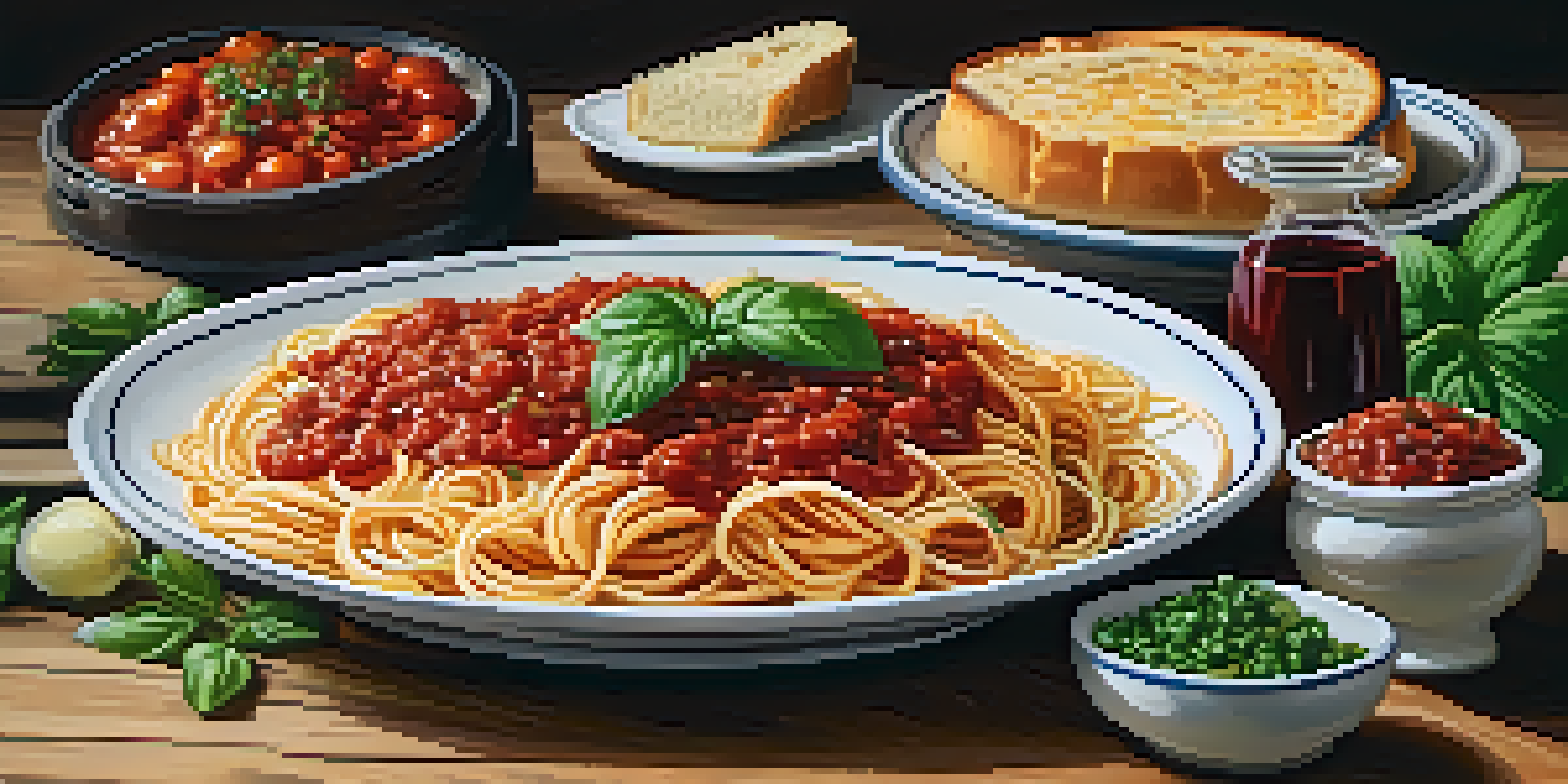Cultural Influences on Dietary Choices and Nutrition

Understanding Cultural Influences on Food Choices
Culture plays a pivotal role in our dietary choices, often dictating what we consider acceptable or desirable to eat. From traditional recipes passed down through generations to modern adaptations, cultural backgrounds shape our preferences. For instance, a family from Italy may prioritize pasta and olive oil, while a family from Japan might focus on rice and fish. Understanding these cultural nuances helps us appreciate the diversity in diets around the world.
Food is our common ground, a universal experience.
Additionally, culture influences not just what we eat, but how we eat. Ceremonial meals, communal dining, and the importance of food in celebrations reflect cultural values and traditions. These practices create a sense of belonging and identity, making food an integral part of cultural expression. For example, the communal aspect of sharing meals in many African cultures emphasizes togetherness and community bonding.
Moreover, cultural influences can extend beyond individual preferences to shape community health outcomes. Diets that are culturally relevant are more likely to be embraced and maintained, making it essential for health professionals to consider cultural aspects when recommending dietary changes. This connection between culture and food highlights the need for tailored dietary interventions that respect and integrate cultural identities.
The Role of Religion in Dietary Choices
Religion significantly impacts dietary restrictions and choices across various cultures. Many faiths have specific guidelines regarding what can and cannot be consumed, influencing the eating habits of their followers. For example, Muslims follow halal guidelines, while Jews adhere to kosher laws. These dietary rules aren’t just about nutrition; they often carry deep spiritual significance and foster a sense of community among believers.

These religious dietary practices can also lead to the creation of unique cultural cuisines. For instance, fasting during Ramadan prompts creative adaptations of traditional dishes to accommodate changes in eating patterns. As communities come together to break their fast, the shared experience enhances social bonds and reinforces cultural identity, showcasing the intersection of faith and food.
Culture Shapes Our Food Choices
Cultural backgrounds significantly influence what we eat and how we prepare meals, creating unique dietary practices across different communities.
Additionally, the merging of cultural and religious dietary practices can lead to fascinating culinary fusions. In places where different cultures intersect, such as in multicultural cities, you may find a blend of flavors and cooking styles that reflect the diversity of beliefs. This fusion not only enriches our palates but also promotes understanding and respect among different cultural groups.
Socioeconomic Factors Affecting Nutrition
Socioeconomic status plays a crucial role in dietary choices and overall nutrition. Individuals from lower-income backgrounds may have limited access to fresh produce and healthy food options, leading to reliance on processed and fast foods. This phenomenon highlights the stark reality of 'food deserts,' areas where nutritious food is scarce, impacting the health and well-being of those who live there.
The act of eating is a cultural act, and it expresses the values of the culture in which it occurs.
Furthermore, education level often correlates with nutritional knowledge, affecting food choices and cooking practices. Individuals with higher education may be more aware of the benefits of balanced diets and the importance of whole foods. In contrast, those with limited nutrition education may struggle to make informed decisions about their diets, perpetuating cycles of poor nutrition and health disparities.
Efforts to bridge this gap include community programs that focus on nutrition education, cooking classes, and initiatives aimed at increasing access to healthy foods. By addressing these socioeconomic factors, we can empower individuals to make better dietary choices and improve their overall health. Such initiatives not only promote personal well-being but also contribute to healthier communities as a whole.
Cultural Traditions and Their Impact on Nutrition
Cultural traditions often dictate the types of foods consumed during holidays and celebrations, significantly influencing dietary habits. For instance, Thanksgiving in the United States is synonymous with turkey and pumpkin pie, while Diwali in India features sweets and savory snacks. These traditions not only enhance the flavor of our lives but also create lasting memories tied to food.
Moreover, the preparation and sharing of traditional dishes can strengthen family ties and cultural heritage. When families gather to prepare meals together, they pass down recipes and cooking techniques that embody their cultural identity. This exchange fosters a sense of belonging and continuity, reminding individuals of their roots and the importance of their culinary history.
Religion Dictates Dietary Rules
Religious beliefs often impose specific dietary restrictions, fostering community identity and leading to the development of unique culinary traditions.
However, globalization poses a challenge to these cultural traditions, as fast food and convenience meals become increasingly dominant. While it’s easy to grab a burger on the go, it’s crucial to recognize and preserve the nutritional wisdom embedded in traditional cuisines. By blending the old with the new, we can create meals that honor our heritage while adapting to modern lifestyles.
Globalization and Its Influence on Dietary Patterns
In today’s interconnected world, globalization has dramatically altered our dietary patterns, introducing us to a variety of cuisines beyond our traditional foods. While this cultural exchange enriches our culinary experiences, it also raises concerns about the loss of traditional diets. As fast food chains spread globally, local food cultures may struggle to maintain their unique identities amidst these influences.
On the flip side, globalization can also facilitate the rediscovery of traditional foods that offer nutritional benefits. For example, the rise in popularity of plant-based diets has led many to explore ancient grains and legumes that were once staples in various cultures. This trend not only highlights the nutritional value of traditional foods but also encourages sustainable eating practices.
Furthermore, globalization fosters a dialogue about food and nutrition, allowing us to learn from diverse dietary practices. As cultures share their culinary knowledge, we can adopt healthier eating habits and create a more inclusive food environment. Embracing this exchange promotes not just personal health, but also a global understanding of nutrition and wellness.
The Impact of Media on Food Choices
In our digital age, media plays a crucial role in shaping our perceptions of food and nutrition. From social media influencers promoting trendy diets to cooking shows showcasing gourmet meals, the media has the power to influence our dietary choices significantly. These platforms often highlight certain foods as 'superfoods' or 'must-try' dishes, which can steer public interest and consumption patterns.
However, the media's portrayal of food can also create unrealistic expectations and pressures surrounding diet and body image. The constant stream of curated food images can lead to comparisons and unhealthy eating behaviors, particularly among young audiences. It's essential to approach these media representations with a critical eye, recognizing the distinction between healthy inspiration and harmful standards.
Socioeconomic Status Affects Nutrition
Economic factors and education levels play crucial roles in determining access to healthy food options, impacting overall community health.
On a positive note, media can also serve as a vehicle for nutrition education and awareness. Campaigns that promote healthy eating, cooking tutorials, and informative content about food sourcing can empower individuals to make better choices. By harnessing the media's influence for good, we can encourage informed eating habits that prioritize health and well-being.
Future Trends: Cultural Adaptations in Nutrition
As we look to the future, the interplay between culture and nutrition will continue to evolve. Increasing awareness of health and wellness is prompting many to adapt traditional diets to meet modern dietary needs. This may include incorporating plant-based options into cultural meals or modifying recipes to reduce sugar and sodium without sacrificing flavor.
Additionally, multiculturalism in urban areas is leading to the fusion of culinary traditions, creating innovative dishes that reflect diverse influences. This trend not only celebrates cultural heritage but also encourages creativity in the kitchen. Imagine a taco filled with traditional Indian curry or sushi made with Mediterranean ingredients—these exciting combinations symbolize the rich tapestry of our global food landscape.

Ultimately, the future of nutrition will depend on our ability to honor cultural traditions while embracing change. As we navigate this journey, it’s vital to strike a balance between innovation and preservation, ensuring that our dietary choices remain inclusive, diverse, and nourishing for generations to come.